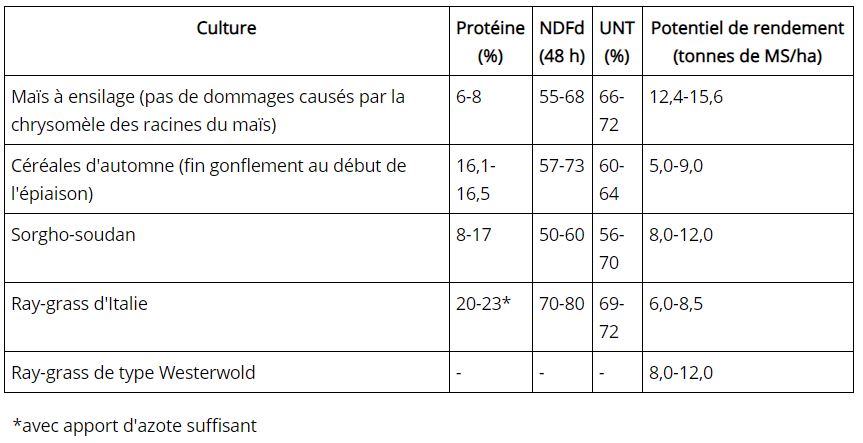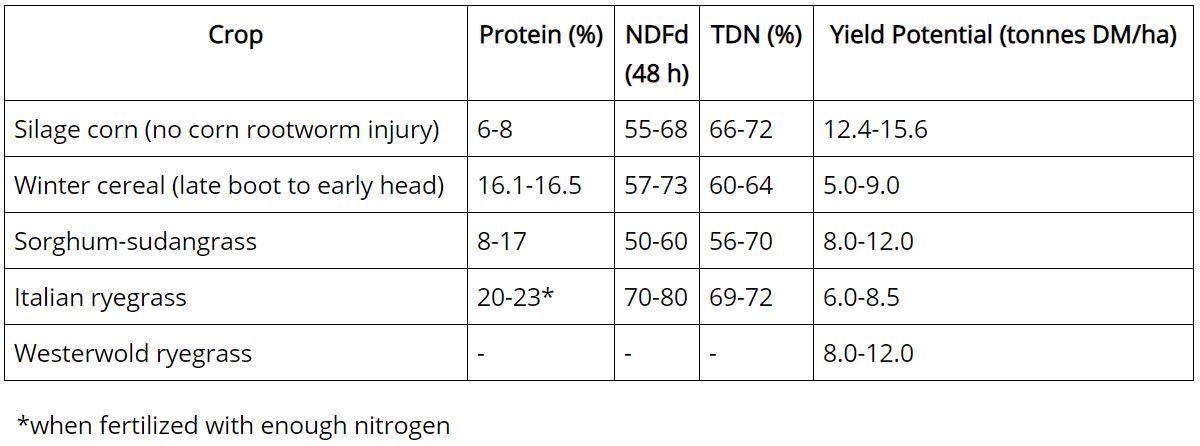Cultures fourragères en remplacement du maïs à ensilage
Le maïs à ensilage est cultivé pour son apport en énergie et en fibres dans la ration alimentaire des animaux d’élevage. Son potentiel de rendement est très élevé. En plus de briser le cycle vital de la chrysomèle des racines du maïs, le recours à d’autres cultures que le maïs à ensilage doit aussi permettre d’obtenir des rendements et une valeur nutritive similaires (voir le tableau 1). Les producteurs agricoles devraient consulter un conseiller en nutrition du bétail afin de s’assurer que les rations sont bien équilibrées.
Tableau 1. Valeur nutritive et rendement type de certaines cultures fourragères annuelles
Ni les céréales d’automne si les différentes espèces de sorgho sont des hôtes de la chrysomèle des racines du maïs. Une double culture de ces deux espèces représente le moyen le plus facile d’obtenir des rendements comparables à une culture de maïs à ensilage sans avoir à subir des dommages attribuables à la chrysomèle des racines du maïs.
On peut maximiser le potentiel de rendement du seigle d’automne s’il est ensemencé durant la période optimale d’ensemencement du blé d’automne.Le seigle peut toutefois bien s’établir après une récolte de maïs à ensilage. Lorsqu’on dispose de fumier et que les conditions le permettent, on peut en épandre avant les semis. Semer à raison de 110 kg/ha (100 lb/acre) et à une profondeur de 2,5 cm (1 po), ou plus profondément pour atteindre la partie humide du terreau. Pour les recommandations sur la fertilisation, consulter le chapitre 4 de la publication 811F du MAAARO : Guide agronomique des grandes cultures. Rappelons qu’il faut tenir compte des éléments nutritifs apportés par le fumier lorsqu’on calcule les quantités d’engrais à ajouter.
Appliquer 55-80 kg/ha (50-75 lb/acre) d’azote au moment où l’herbe commence à reverdir au printemps afin de stimuler le tallage et d’augmenter les rendements fourragers. Le seigle doit être récolté entre le stade de la sortie de la feuille de l’épi et le début du gonflement si l’on veut obtenir un fourrage de meilleure qualité. Cette période survient normalement entre le 10 et le 20 mai dans le sud de l’Ontario. Faucher la culture au stade optimal de maturité et de préfanage afin d’obtenir la teneur en humidité voulue pour l’ensilage ou la mise en grosses balles. Si le seigle montre des signes de repousse, l’application d’un herbicide de contact pour détruire la récolte va permettre de préparer le champ pour y ensemencer du sorgho-soudan.
On peut aussi semer du triticale d’automne au lieu du seigle. Les taux de semis et les besoins en éléments nutritifs sont les mêmes. Le triticale est habituellement prêt à être récolté 10-14 jours plus tard que le seigle. Quand les récoltes de seigle ou le triticale surviennent en même temps que les ensemencements d’autres cultures au printemps, la récolte de céréales devrait être prioritaire afin d’assurer la qualité de cette dernière.
Le sorgho-soudan exige des températures du sol supérieures à 12 °C pour germer. Les conditions propices au semis surviennent donc habituellement à la dernière semaine de mai ou au début juin dans le sud de l’Ontario. Lorsqu’on dispose de fumier et que les conditions le permettent, on peut en épandre avant les semis. Semer à raison de 33-44 kg/ha (30-40 lb/acre) et à 2-4 cm (0,75-1,5 po) de profondeur. Respecter les recommandations sur les apports en phosphore et en potassium concernant le maïs (voir le chapitre 1 de la publication 811F du MAAARO : Guide agronomique des grandes cultures). Rappelons de tenir compte des éléments nutritifs apportés par le fumier lorsqu’on calcule les quantités d’engrais à ajouter. Appliquer 80-100 kg/ha (90-110 lb/acre) d’azote réel d’abord, et 50 kg/ha (45 lb/acre) après la première coupe.
Le sorgho-soudan est une culture qui comporte deux coupes. On doit le récolter avant l’apparition de l’épi, ce qui se produit habituellement 60 jours après le semis. Au moment de la fauche, le teneur en humidité de la culture est d’environ 70 à 75 % et un préfanage est requis avant l’ensilage ou la mise en grosses balles. Cette culture sèche plus lentement que la luzerne. Afin de stimuler la repousse, laisser de 10 à 18 cm (4 à 7 po) de chaume à la récolte. On peut normalement faire la deuxième coupe 30 à 35 jours après la première. S’assurer que la culture mesure au moins 65 cm (26 po) de hauteur avant de la faucher. Attendre qu’elle repousse un peu, puis appliquer un herbicide de contact (glyphosate) sur le sorgho-soudan afin de préparer le champ à être réensemencé en seigle.
On peut aussi remplacer la culture de maïs à ensilage par un ray-grass annuel, soit le ray-grass d’Italie ou celui de type Westerwold. Le ray-grass d’Italie a besoin de vernalisation comme les céréales d’automne, et il ne produit donc pas d’épi l’année du semis. Le ray-grass de type Westerwold se comporte davantage comme les céréales de printemps puisqu’il va produire des épis l’année du semis. Les deux cultures sont toutes deux très appréciées des ruminants, mais elles peuvent être des hôtes secondaires de la chrysomèle des racines du maïs. Afin d’empêcher les populations de cet insecte de survivre dans le ray-grass et de faire une transition entre deux cultures de maïs, le ray-grass devrait être soit suivi d’une culture non-hôte ou être cultivé au moins trois ans avant que l’on revienne au maïs.
Semer le ray-grass à raison de 30-40 kg/ha (27-36 lb/acre) et à 6 à 12 mm (0,25-0,5 po) de profondeur. Lorsqu’on dispose de fumier et que les conditions le permettent, on peut en épandre avant les semis. Les besoins en phosphore et en potasse sont les mêmes que pour les cultures fourragères vivaces (voir le chapitre 3 de la publication 811F du MAAARO : Guide agronomique des grandes cultures). Les ray-grass ont besoin de beaucoup d’azote. On doit donc appliquer 55 kg/ha (50 lb/acre) au démarrage et répéter l’épandage après chaque coupe, sauf après la dernière fauche de l’année.
Toutes ces possibilités entraînent très rapidement des pertes de qualité et de palatabilité si la récolte est retardée. Ces cultures fourragères de remplacement peuvent être semées et récoltées avec la machinerie habituelle utilisée pour les fourrages.
~~~
Silage corn is grown to provide energy and fibre in a ration. It has very high yield potential. In addition to breaking corn rootworm lifecycles, alternatives to silage corn need to offer similar yield and nutritional value (Table 1). Producers should consult a livestock nutritionist to ensure rations are properly balanced.
Table 1. Typical nutritional quality and yield of some annual forage crops

Neither winter cereals nor sorghum species are host crops for corn rootworm. Double cropping these two species is the easiest way to achieve comparable yields to a silage corn crop that does not have rootworm injury.
Yield potential of fall rye is maximized when seeded on the optimum seeding date for winter wheat. However, rye can be successfully established after silage corn harvest. Where available and conditions permit, apply manure ahead of seeding. Seed at a rate of 110 kg/ha (100 lbs/acre) and at 2.5 cm (1 in.) depth, or deeper to seed into moisture. For fertility guidelines, see Chapter 4 of OMAFRA Publication 811: Agronomy Guide for Field Crops. Remember to account for nutrients from manure when calculating fertility requirements.
Apply 55-80 kg/ha (50-75 lbs/acre) of nitrogen at green-up in the spring to encourage tillering and increase forage yields. Rye should be harvested between flag-leaf and early boot stage for high-quality forage. In southern Ontario this typically occurs between May 10-20. Cut the crop at the optimum maturity stage and wilt to the target moisture for ensiling or baleage. If the rye shows signs of regrowth, a burn-down to terminate the crop will prepare the field for seeding sorghum-sudangrass.
Winter triticale can be substituted for fall rye. Seeding rates and fertility requirements are the same. Triticale is typically ready to harvest 10-14 days later than rye. Where rye or triticale harvest conflicts with planting other crops in the spring, harvesting the cereal should take priority to maintain quality.
Sorghum-sudangrass requires soil temperatures above 12°C to germinate, so conditions to seed generally occur in the last week of May or early June in southern Ontario. Where available and conditions permit, apply manure ahead of seeding. Seed at a rate of 33-44 kg/ha (30-40 lbs/acre) and at 2-4 cm (0.75-1.5 in.) depth. Use the phosphorus and potassium guidelines for corn (see Chapter 1 of OMAFRA Publication 811: Agronomy Guide for Field Crops). Remember to account for nutrients from manure when calculating fertility requirements. Apply 80-100 kg/ha (90-110 lbs/acre) of actual nitrogen up front, and 50 kg/ha (45 lbs/acre) after first cut.
Sorghum-sudangrass is a two-cut crop. It should be harvested before heads emerge, which is typically about 60 days after planting. At cutting, the crop is about 70-75% moisture and requires wilting before ensiling or making baleage. It dries slower than alfalfa. To encourage regrowth, leave 10-18 cm (4-7 in.) of stubble when harvesting. A second cut is typically ready 30-35 days after the first cut. Ensure that the crop is at least 65 cm (26 in.) tall before cutting. Wait for some regrowth, then terminate the sorghum-sudangrass with glyphosate to prepare the field to go back into rye.
Another option to replace silage corn is an annual ryegrass, either Italian or Westerwold. Italian ryegrasses have a vernalization requirement like winter cereals, so they do not head out the year they are planted. Westerwold ryegrasses are more like spring cereals in that they will head out in the establishment year. While both are highly palatable to ruminants, they may be an alternate host for corn rootworm. To prevent rootworm populations from surviving on ryegrass and “bridging” between corn crops, ryegrass should either be followed by a non-host crop or grown for at least three years before rotating back to corn.
Seed ryegrasses at 30-40 kg/ha (27-36 lbs/acre) and 6-12 mm (0.25-0.5 in.) depth. Where available and conditions permit, apply manure ahead of seeding. Phosphorus and potash fertility are the same as for perennial forages (Chapter 3 of OMAFRA Publication 811: Agronomy Guide for Field Crops). Ryegrasses have very high nitrogen demands, so apply 55 kg/ha (50 lbs/acre) up front, and again after each cut except the last one of the year.
All these options lose quality and palatability very quickly if harvest is delayed. These alternative forages can be seeded and harvested with conventional forage equipment.


